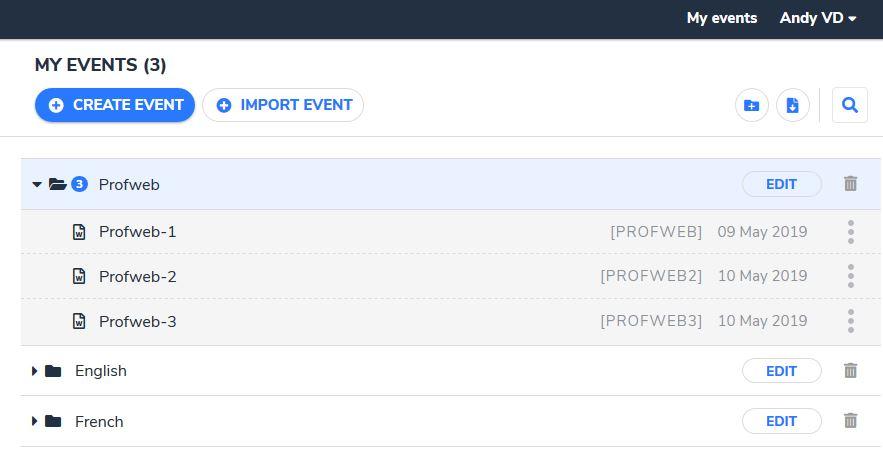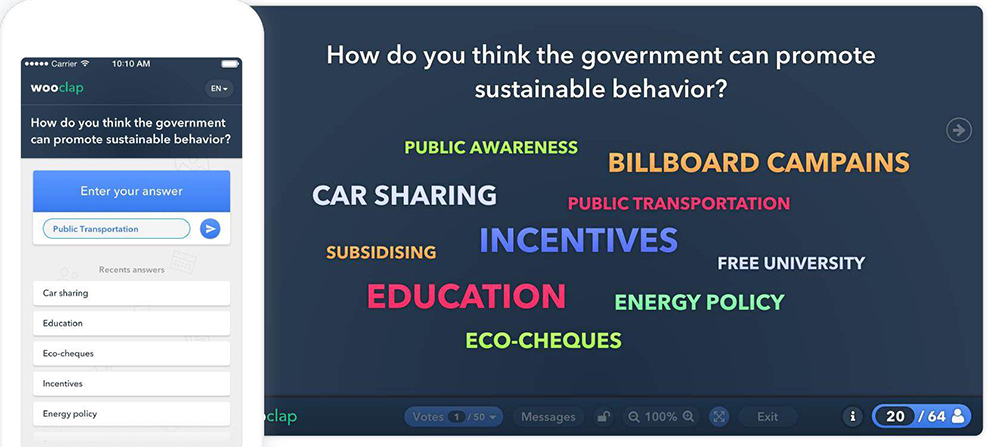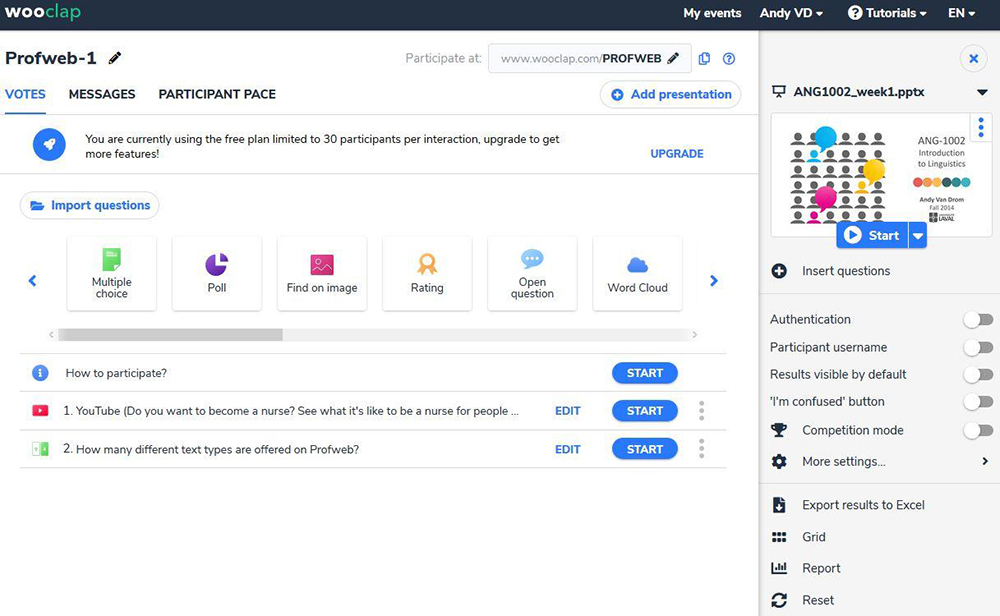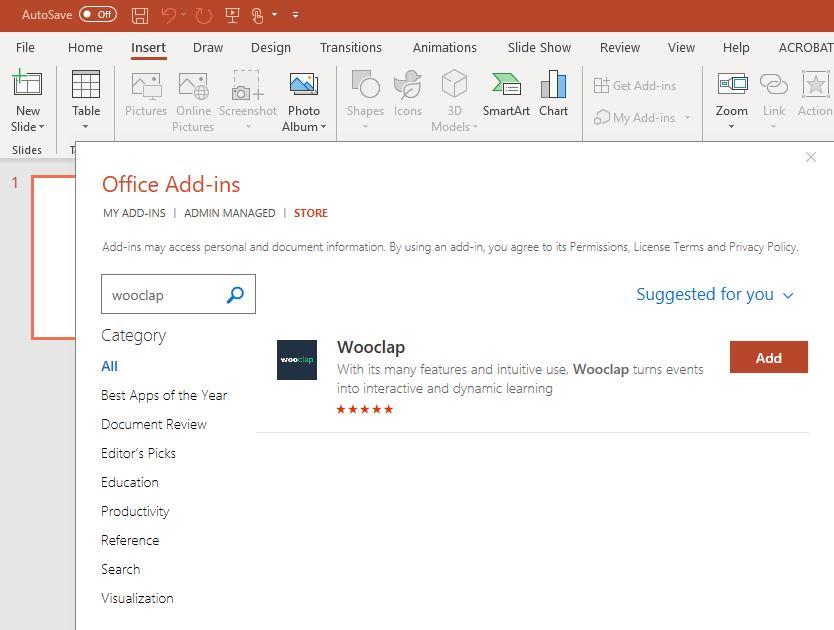Wooclap: A Versatile Tool to Poll Students

This Digital Tool is licensed under a Creative Commons Attribution-NonCommercial 4.0 International License.
In the ever-growing landscape of so-called audience response systems – tools and platforms allowing you to efficiently poll students in a variety of situations – Wooclap stands out because of its versatility and the fact that it was designed specifically for higher education contexts. The free version can be used with groups of up to 30 students; additional access and features are available for a monthly fee.
Getting Started
The Wooclap platform is available in 6 languages, including English, French and Spanish, through the button in the top-right corner of the homepage. The signup procedure is straightforward; after entering your email address and choosing a password, the platform collects some information on your institutional affiliation and role (professor or student) and sets up your account. On subsequent visits, use the login button to connect to the platform.
It is also possible to log in to Wooclap using social media (Facebook, Google or LinkedIn credentials) rather than an email address; however, setting up an account this way prevents you from using the PowerPoint plugin (at the time of writing). It does not limit the web-based interface’s functionalities.
Creating an Event
Once logged in, you are redirected to the My Events page. Wooclap defines an event as “any gathering during which you’d like to interact with your audience, such as a class.” However, since an event is merely a container page regrouping presentation files and interactive elements, you can choose to use it to organize the content of one class, one class group, or even an entire course.
Before creating new content, it is important to plan the structure you wish to use to ensure you can easily retrieve and reuse your presentation files and interactive elements:
- Each event is associated with a code, so regrouping all course content on the same event page allows you to use the same connection code with your students from week to week.
- Although there are no limits to the number of files and interactive elements you add to an event, all items are displayed in one list. Splitting content over different events may make it easier to navigate your content as you add more items but requires you to share a new code with students for each event.
- Finally, you can also group several events in folders to further organize content.

Screenshot of the My Events screen. The example contains 3 folders (French, English, Profweb); the latter contains 3 so-called Events.
Beside creating new events and editing or duplicating your existing events, from this page, you can also:
- Import events from Moodle. This requires exporting a Moodle quiz as an xml file and uploading it to Wooclap.
- Import events shared by colleagues. This requires entering a code provided by the other person. It can be located on the event page by clicking on the cog wheel icon (top right) and choosing “more settings.”
Creating Interactive Elements
From each event page, users can create 15 types of questions, all of which can be optionally timed by toggling the timer function and setting a value in minutes and seconds:
- Multiple-choice. A classic quiz format that allows students to answer your question by selecting the correct answer(s) from a list. You can add unlimited answer options and determine whether there is one or more correct answers. Answer options can consist of text or images.
- Poll. Based on the multiple-choice format, this question type allows you to poll your students’ opinions on questions that do not necessarily have a right or wrong answer.
- Find on image. After uploading an image, you can formulate a question and identify the area on the image corresponding to the answer. Students will need to click or tap in this area to obtain a correct answer.

Demonstration of a Find on image question. (Image source: Wooclap press kit)
- Rating. This question format allows you to elaborate a list of statements, each of which students need to rate using a star system. You can set the scale from 1-4 to 1-10.
- Open question. Students can type the answer to the question provided. You can set a maximum number of characters and determine whether the answers will be graded.
- Word cloud. Based on the open question format, students’ answers (ideally 1 word or short phrase) are compiled and visually rendered as a word cloud on the screen.

Demonstration of a Word cloud question. (Image source: Wooclap press kit)
- Find a number. This format allows you to ask a question requiring a numerical answer. Optionally, you can set a minimum and maximum value. The answers given can be displayed as a grid or list.
- Matching. Items in 2 lists need to be matched by the students. Optionally, one of the items in the pair can consist of an image.

Demonstration of a Matching question. (Image source: Wooclap press kit)
- Prioritisation. Based on the rating format, students attribute a total 100 points between the different statements provided. The points are compiled and displayed for the entire group.
- Sorting. Based on the rating format, students need to rank and order the statements provided based on the criterion expressed in your question.
- Fill-in-the-blanks. Based on the open question format, this question asks students to write the missing word(s) in a statement.
- Slide. This is not a question format as such but allows you to quickly project textual information without uploading a PowerPoint or Slides file.
- Brainstorming. Based on the open question format, you can ask a question and determine categories in which you wish students to make suggestions. After choosing a category, they can type their answer, which can be displayed using a sticky notes format or in a grid.

Demonstration of a Brainstorming question. (Image source: Wooclap press kit)
- Script concordance test. This question format is mostly used in health-related fields but can be used by anyone wishing to get students to reflect on the impact of a piece of information on the validity of a hypothesis. After describing a situation, a hypothesis and a new piece of information, you can ask students to evaluate the impact between “strongly negative” and “strongly positive” on a 4-point scale.
- Video. This is not a question format as such but allows you to quickly share video content from a web link or your hard drive (mp4 file of maximum 200 MB).
It is also possible to import a question from another event or from an Excel file. For the latter option, the platform provides a template to follow to ensure a smooth transfer.
Presenting Interactive Elements
Once interactive elements have been created on the event page, they can be presented in 3 different manners from the Votes tab:
- Questions can be administered directly from the platform by clicking the Start button next to the item you wish to project.
- Questions can be integrated in a PDF, Powerpoint or Keynote presentation uploaded from your hard drive (file of 50 MB) or from a Google Slides link. After uploading and selecting your presentation file (top right), click the Insert Questions button to open a window allowing you to insert the desired interactive elements in between the existing slides. It is important to note that elements such as special fonts or animations may not be available when presenting through the Wooclap platform. The interactive elements remain on the Wooclap platform and are not added to your original presentation file.
- A Wooclap Add-in is also available for Powerpoint. It can be downloaded from the Add-ins menu (under the Insert tab). After logging in, you can access the events and interactive elements created on the Wooclap platform and insert them in your presentation slides in the form of elements that behave as images. This has the benefit of maintaining the visual integrity of your presentation but does still require an Internet connection to use the interactive content pulled from Wooclap.
Additional presentation features can be toggled on or off:
- Students can be required to log in through email or social media.
- Students can be asked to choose a username to be displayed on the results screens.
- Poll results can be hidden or made visible.
- The competition mode generates a leaderboard that ranks students based on the number of correct answers given.
- An “I’m confused” button makes it possible for students to easily and quickly signal something they haven’t understood.
The More Settings button gives access to further configurable options:
- Voting can be allowed by web and/or text message (a minimum of 1 option is required).
- Presentation slides can be displayed on students’ devices (by default, only questions are displayed).
- The theme and colour scheme can be adapted.
- Exporting results to Excel or Moodle is available only on paid accounts.
The Messages tab allows you to activate the Wall, which is a space where students can post comments and questions. Optionally, students can also be given the opportunity to upvote others’ contributions. Consulting the wall can be restricted to the teacher; it can also be projected by clicking the Display the Wall button.
The Participant Pace tab is not available in free subscriptions plans. It allows you to create questionnaires by compiling existing interactive items for students to work through at their own pace.
Further Information
The Wooclap introductory video and user guide may provide you with further insight into the platform. François Simard’s article on his use of Wooclap is also available from Profweb.








